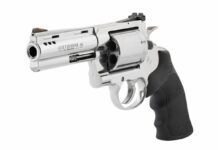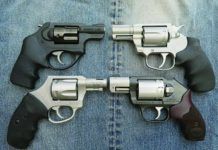Some of the more useful handguns are those revolvers that take the .44 Special cartridge. They work well for hunting, self defense, and we know one shooter who used one to good effect in NRA matches. These revolvers include the .44 Magnum, but many .44 Mags are huge, heavy handguns designed to use the hottest loads in the longest barrels, for such efforts as hunting. While the big .44 is very good at that task, the other – probably more useful – side of the cartridge is as a general-purpose firearm for self defense or for the hiker or plinker who wants more power than the over-loud .357 Magnum. These outdoorsmen dont want a big, heavy gun, but want a lighter package that still throws a 250-grain bullet at useful speed. The .44 Special fills that bill very well.
There have been a few small .44 Special revolvers on the market, perhaps none so obvious as the Charter Arms Bulldog. Charter was not alone. Taurus just informed us they recently discontinued a similar-size .44 revolver because of lack of sales. We suspect many shooters had no idea the small Taurus .44 existed, mores the pity. We just found out S&W made a short run of 5-shot revolvers on the L frame, and would love to get our hands on one. But Charters near-snubby-size, five-shot revolvers have been around a long time. Those who own them generally like them, though they are hardly target-grade revolvers. With suitable loads they can be excellent self-defense revolvers, but with really hot loads they can be a handful. Some shooters prefer a larger gun for the .44 Special cartridge, but there arent all that many available, so the obvious choice is a light .44 Magnum with mild loads.
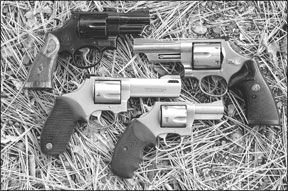
We gathered two relatively light .44 Magnums, one an older stainless S&W Mountain Gun, today offered in a blued special edition for about $1000. We also got a new five-shot, stainless Taurus Tracker, $584. And we acquired two .44 Specials, a stainless Charter Arms Bulldog Pug, $399, and S&Ws just-reissued 3-inch Model 24, another special-edition revolver, $1100. We also examined and shot an earlier blued Charter Bulldog, but did not include it in the final report. We wanted to see what changes were made over the years. We tried the four revolvers against each other for general outdoorsmens purposes, with an eye to easy carry, self defense, and overall usefulness. We tested all guns with .44 Special ammunition only, except as noted. We used Black Hills Cowboy Action loads, which feature a 210-grain cast-lead, flat-nose bullet. We also tested with CCI Blazer 200-grain GDHP, and with an unusual load from Black Hills we had not heard of before. This was the .44 Special “Thunder Ranch Special” ammunition, loaded with a 250-grain SWC cast Keith-style bullet. This ammo is available from Black Hills through any stocking dealer, in case you fall in love with it like we did. Any concealed-carry handgun is better off loaded with factory ammunition – not handloads – because of legal reasons. Keith-type cast SWC bullets have been outstanding performers ever since Elmer designed them in the early part of the last century. However, they are not commonly loaded by any large manufacturer, so this find from Black Hills was a revelation for us. Heres what we found.
Charter Arms Bulldog Pug
.44 Special, $399
The matte-stainless, five-shot Pug looked just right. It had highly visible fixed sights, comfortable yet not bulky rubber grips, and a 2.5-inch barrel with a shroud that protected the ejector rod. The front sight was integral with the barrel. If we owned this, wed serrate the ramped rear of the front sight blade with a checkering file to cut potential glare, though we had no such problems during our testing. We also would like a touch more clearance in the sight picture between the front blade and the rear notch. But for the most part, we liked the look and feel of this potent package right from the start.
In a side-by-side comparison with the older blued Bulldog we saw few differences, but they were big ones. As of this writing you get only a 2.5-inch barrel on the Bulldog Pug, despite rumors of Charter offering 2, 4, and 6-inch barrels on this gun. The only Bulldog today is labeled the Bulldog Pug on its barrel and comes with a 2.5-inch barrel. Our sample, and several weve seen on the Internet have the company name as “Charter 2000/Shelton, Conn” on the barrel in two lines. The older gun had “Charter Arms Corp. Bridgeport, Conn.” in one line. The new barrel has an integral front sight. The older one looks to have had a separate assembly welded on. The new one has a shroud under the barrel protecting the ejector rod. The old one hung in the breeze. Gone is the cylinder-retention lug from the left side of the frame. The new hammer is a touch longer on top, making the new gun easier to cock. Unfortunately, the new gun doesnt have quite the solid lockup of our earlier sample. We found it possible to slightly rotate the cylinder of the new gun with the hammer in the firing position. The older gun was like a rock. Nothing moved. Both, happily, have excellent, smooth double-action pulls, lighter than both of the S&W revolvers, though the feel was not the same. Given the choice between the older and newer versions, assuming both were stainless, wed instantly pick the newer one. Workmanship on the new gun appeared to be excellent. The gun had a pleasant, well-finished appearance.
On the range we found the Pug to be a handful. Recoil was there, and it could bite the unexpected. We learned to insert the trigger finger until the second finger segment was on the SA trigger, or else it get it banged in recoil. All three types of ammunition hit close enough to our point of aim that we didnt miss adjustable sights. Accuracy was not great, best groups going about 2.5 inches at 15 yards. Groups with the new gun were slightly better overall than with the older Charter, despite the latters tighter lockup and longer barrel. The older Charter had been fitted with wood grips by its owner. These gave us some of the greatest discomfort weve experienced with handguns of any size. There was not enough room for the fingers, and the trigger guard rammed into our second finger hard enough to potentially cause damage, so we replaced them with a set of Pachmayr “Gripper” stocks, which made this into a much bigger handgun, but one we could shoot. The new guns rubber grip was extremely comfortable, and much smaller than those huge Grippers.
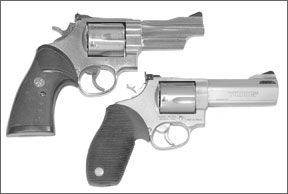
We found a slight problem with the Charter. During our accuracy testing we noticed the lockup was not perfect. The latch button did not move all the way to the rear when the cylinder was fully closed. The older Bulldog had a latch button that moved about a tenth of an inch rearward as the cylinder pin went home into the recoil shield. This did not happen with the new Pug. In fact, a light tap on the closed cylinder with the heel of our hand would cause the Pugs cylinder to open. We found a burr in the hole in the recoil shield, which prevented the cylinder pin from entering. We ran a drill bit into the hole with our fingers to clear the burr, but the pin would still not go fully home. We found another burr on the end of the cylinder pin, which was easily removed with a file. After a few minutes work, the lockup was fixed. Yes, the factory ought to have caught this. This slight flaw could have caused early wear on many of the guns parts, so be sure to check yours. With the lockup corrected we retested our loads, but got no significant changes in accuracy.
Smith & Wesson Model 24
.44 Special, $1105
Smith & Wesson has been reintroducing a few classic or older-type handguns over the past few years, largely through the distributor Lew Horton. We were lucky enough to acquire a Model 24, with a 3-inch barrel, for this report. Back in 1950 the “.44 Hand Ejector Target Model of 1950” first made its appearance on the shooting scene. It was not a resounding success, except with guys like
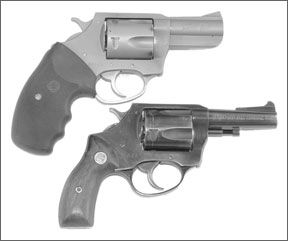
Elmer Keith. Keith successfully hot-rodded the .44 Special with cast bullets of his own design, and wrote up the potent combination in various magazines over quite a few years. His work and persistence led to the introduction of the .44 Magnum in 1956, and that fine handgun in turn contributed to the discontinuance of the .44 Special “Hand Ejector” or Model 24 as it was then known, in about 1966. There have been a few excursions into the realm of the Model 24 in succeeding years, and we even tested one on these pages a few years back.
This new (limited edition) Model 24 comes in either nickel or blue. It is built on the N frame, and has a square-backed grip frame. The pinned-in front sight had a red insert, and there was a white outline on the adjustable rear-sight blade. Although the gun is chambered and marked for the .44 Special, the external cylinder length is the same as that of the .44 Magnum.
The attractive reddish-colored wood grips were in the old “Magna” shape, with an upward extension designed to cushion the web of the hand from the upper portion of the frame. Unfortunately these grips dont come all the way to the rear of the frame and thus that cushioning effect is somewhat diminished. The grips were checkered in the early S&W pattern, leaving a wood diamond around the grip screw. The checkering was exceptionally well done, and included an incised outline. The grips also held the S&W logo. Others modern features were the hammer lock in the frame just above the cylinder release, and the firing pin mounted in the frame. The hammer and trigger were case colored. The barrel was not pinned to the frame. The gun did not use the ball-detent locking system seen recently on some S&Ws, but instead relied on the ejector rod at the front and the cylinder pin entering the recoil shield at the back. With its shorter barrel the Model 24 weighed 38.4 ounces, compared to 42.9 for the Mountain Gun, more than a quarter-pound difference.
Fit and finish were excellent, other than the grips that didnt fit quite right. (Early Magna grips looked like they grew in place.) The
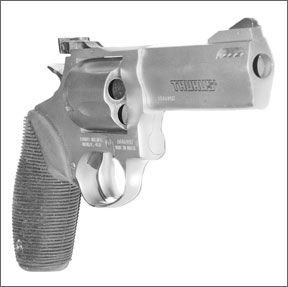
Model 24s SA trigger broke at 4.8 pounds. The DA pull was over 14 pounds, though very smooth. The M24 Smith was not quite as slick in DA as the older Mountain Gun, but it appeared to be about as accurate. However, it took more effort from our shooters to get accuracy equal to the other gun, something for the outdoorsman to consider. The adjustable sights gave us center hits at 15 yards, and the point of impact between loads didnt change much. The M24s wood grips made this gun less comfortable to shoot than the Charter Pug with any given load. The charm of the Model 24 with its attractive, square-back Magna stocks is unquestioned, and it went easily into and out of our coat pocket with em, but if youre going to shoot it a lot rubber grips will be kinder to most hands. Our best accuracy was with the Keith-bullet Black Hills ammo, which averaged around 1.5 inches at 15 yards, with many four-shot clusters cutting a single hole.
Taurus Stainless Tracker .44
Magnum, $584
The five-shot Tracker had a most comfortable grip of fluted or finned rubber, which we liked a great deal. This 4-inch revolver was noticeably smaller than the N-frame Smiths, and weighed less as well. The Tracker had a built-in muzzle brake to help it combat the fierce recoil of full-power .44 Magnum loads. The brake had its exhaust ports next to the front sight, and was formed by a counterbore into the muzzle end of the rather massive barrel and lug assembly. The guns exterior finish was matte stainless, very well done and most attractive, we thought. The sights were fully adjustable, and consisted of a ramped front with a bright red insert and a white-outlined rear. These sights were easier to see in most light than those on either of the two Smiths, we thought. However, in some light it was possible to get a glare off the plastic insert.
The Tracker had the clever Taurus safety lock in its hammer. Cylinder lockup was by the rear pin and by a sprung detent at the yoke which didnt appear to do a whole lot, but apparently did enough. Cylinder lockup was good and tight, and stayed that way throughout our testing. The single-action pull was consistent at 4.8 pounds. The DA pull was very smooth at 10.2 pounds, best of the test. The workmanship was also excellent everywhere, and we really liked the rounded cylinder-release button.
With a weight of 34.6 ounces empty, the Tracker was a quarter pound lighter than the Model 24 and over half a pound lighter than the Mountain Gun. Still, it was much heavier than the Charter Pug (19.8 oz.). If the Taurus were chambered for the .44 Special and had a lighter barrel without that noisy brake, wed like it even more. However, for a revolver that accepted the .44 Magnum, this was one of the lighter and handier ones weve seen. We had to try it with full loads. Some of us have never been fond of muzzle brakes, and for our .44 Special loads we didnt really need one. However, for a few full-power .44 Magnum loads the brake was most welcome here. We found the Tracker was a lot more comfortable to shoot than the Mountain Gun with .44 Mag loads, despite its over half a pound less weight. Taurus is really onto something with this delightful little revolver.
On the range, with two of our loads we got groups about equal to those from the two Smiths, and significantly better accuracy than from the Pug. The Keith load seemed to give a bit of leading, and we suspect fire-lapping or a few hundred rounds of jacketed bullets would cure that. We believe the Tracker would be well worth the slight effort of doing this, because even with the Keith bullet, we got three or four shots cutting one ragged hole and the remainder spoiling the group. We saw this to some extent with the Cowboy loads too. The accuracy potential is clearly there. We didnt feel that the five-shot cylinder was any sort of limit or restriction.
Smith & Wesson Mountain Gun
.44 Magnum About $1100
Our Mountain Gun was a few years old, and has seen almost no shooting. It was finished in semi-glossy stainless, and was fitted with relatively large Pachmayr rubber grips. Unlike the normal 4-inch Model 29, the Mountain Gun featured a slim barrel and rounded butt beneath the huge stocks. It was a bit lighter than the standard Model 29, 42.9 vs. 44.0 ounces, and that made it a bit easier to carry.
Also, it was the largest and heaviest gun of this group, but also the most accurate and easiest to shoot well. It was also the shiniest gun of the group, catching more light than even the blued Model 24. Fit and finish here were probably the best of the four test guns. The DA pull was smooth and useful at 12 pounds. The SA pull was clean at 4.1 pounds. The sights were black on black, with a ramped, serrated front and fully adjustable rear. The firing pin was in the hammer, and the frame was drilled for scope mounting. There was no frame lock. A nice finishing touch was that the fronts of the cylinder outlets were chamfered like those of a single-action Colt of early vintage.
On the range, we got the best accuracy of all four guns with the Mountain Gun. Several groups had four in a hole lots smaller than an inch, with the fifth opening it up to 1.5 inches or so. Again we got a touch of leading and again we feel the gun needs some shooting to smooth its bore for best work with lead bullets. As noted we fired this gun against the Taurus with a few full-power Magnum loads, and we all preferred the Taurus.
Final Questions
The question of the intended use for each of these guns must be answered by each potential buyer before he parts with his cash. If you want a .44 to stick in your pocket, get the Charter. If you can tolerate a bigger gun with a short barrel and dont mind paying nearly three times as much for it, go for the Model 24, but wed guess that if you can tolerate that size gun youll be better served with the Mountain Gun, or with a normal Model 29 with 4-inch barrel. However, if youre looking for a longer-barreled handgun of that power, but without the weight, by all means consider the Taurus Tracker. We think youll be pleasantly surprised, just as we were.



























